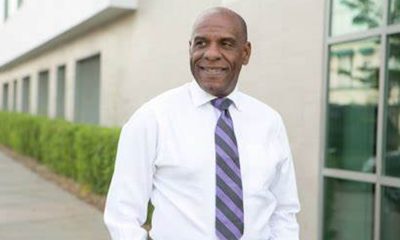Community
Opinion; How You Can Help Your Kid Readjust to In-Person Schooling
Over time, if our kids are not able to relax and de-stress, their bodies may also react with headaches, stomach aches, rapid heart rates, and an overall feeling of unwellness.

Our children are our most precious resource. They hold in their hands the future of our community, our state, and our nation. Likewise, we must hold them, too, under our protective guidance as we shape them into responsible and caring adults.
Now that most of our students have returned to school after an unusual, unpredictable and challenging 18 months due to COVID-19, many of our children are experiencing emotional upheavals due to – or exacerbated by — the pandemic. It is going to take some work to get children used to the stability, structure and predictability after more than a year of remote learning, disrupted schedules, isolation, little-to-no contact with peers and missed milestones.
Some of our children and their families have experienced food insecurity, income losses, illness and death due to COVID or related traumas. These factors and many more have contributed to rising rates of depression, anxiety, hopelessness, decreased motivation, irritability, and an overall loss of learning.
As the school year begins, it is important to remember that each child is unique, and each one will experience their transition back to school differently. According to the American Psychological Association (2021), 81 % of Gen Z teens (those between the ages of 13-17) have experienced intense stress associated with academic learning due to the COVID-19 crisis. Rates of depression and anxiety in African American youth have increased also. Rates of suicidal ideation are climbing among Black youth as well but remains highest among LGBTQ+ youth across racial categories. Moreover, in September 2020, over half of 11-17-year-olds reported having thoughts of suicide or self-harm.
Children experience stress differently than adults. Usually, stress resolves itself within weeks for most youth. For others, though, the stress may turn into anxiety and influence the child’s thoughts and behavior.
Here are some things to look for: changes in mood (irritability, hopelessness, frequent conflicts), changes in behavior (little time with friends, increase in video chatting or texting), loss of interest in previously enjoyed activities, difficulty falling or staying asleep, and/or a change in appearance (personal hygiene).
Over time, if our kids are not able to relax and de-stress, their bodies may also react with headaches, stomach aches, rapid heart rates, and an overall feeling of unwellness.
So, what can you as a parent do to help your child? Here are some recommendations.
- Get organized and plan for the school day.
- Talk with your student about any concerns that they may have returning to school. Even if school has started, ask and listen to how the school days have progressed.
- Try reaching out to another parent if your child is having difficulty making new friends. Plan a playdate or hangout time.
- Have a consistent and reliable schedule for waking up, going to bed, and for meals.
- Talk to your child about what they have to look forward to whether it’s the next school day or the end of the week.
- Listen to your students concerns and do not dismiss what you hear. Try to validate their experiences whether you can relate to them or not.
- Please follow CDC guidelines as well as your school district’s policies for staying safe in order to decrease the spread of COVID and its variants.
- Practice meditation. Just being still and quiet for three minutes will help to protect ourselves from stress, anxiety and depression upon waking up, at dinner or before bed.
Finally, we all must recognize the additional pressure placed on many of our students during the Black Lives Matter movement. We must continue to actively advocate, support, empathize and listen to our children as they develop tools needed to face the challenges of life today.
Remember to keep the lines of communication open and reach out to a trusted expert such as your pediatrician or family care doctor.
Some licensed psychologists, including myself, offer screenings for depression, anxiety, hopelessness, stress, etc. as well as treatment with effective tools and strategies for success are available.
Activism
Oakland Post: Week of April 24 – 30, 2024
The printed Weekly Edition of the Oakland Post: Week of April 24 – 30, 2024

To enlarge your view of this issue, use the slider, magnifying glass icon or full page icon in the lower right corner of the browser window. ![]()
Alameda County
DA Pamela Price Stands by Mom Who Lost Son to Gun Violence in Oakland
Last week, The Post published a photo showing Alameda County District Attorney Pamela Price with Carol Jones, whose son, Patrick DeMarco Scott, was gunned down by an unknown assailant in 2018.

Publisher’s note: Last week, The Post published a photo showing Alameda County District Attorney Pamela Price with Carol Jones, whose son, Patrick DeMarco Scott, was gunned down by an unknown assailant in 2018. The photo was too small for readers to see where the women were and what they were doing. Here we show Price and Jones as they complete a walk in memory of Scott. For more information and to contribute, please contact Carol Jones at 510-978-5517 at morefoundation.help@gmail.com. Courtesy photo.
City Government
Vallejo Welcomes Interim City Manager Beverli Marshall
At Tuesday night’s Council meeting, the Vallejo City Council appointed Beverli Marshall as the interim city manager. Her tenure in the City Manager’s Office began today, Wednesday, April 10. Mayor Robert McConnell praised Marshall’s extensive background, noting her “wide breadth of experience in many areas that will assist the City and its citizens in understanding the complexity of the many issues that must be solved” in Vallejo.

Special to The Post
At Tuesday night’s Council meeting, the Vallejo City Council appointed Beverli Marshall as the interim city manager. Her tenure in the City Manager’s Office began today, Wednesday, April 10.
Mayor Robert McConnell praised Marshall’s extensive background, noting her “wide breadth of experience in many areas that will assist the City and its citizens in understanding the complexity of the many issues that must be solved” in Vallejo.
Current City Manager Michael Malone, whose official departure is slated for April 18, expressed his well wishes. “I wish the City of Vallejo and Interim City Manager Marshall all the best in moving forward on the progress we’ve made to improve service to residents.” Malone expressed his hope that the staff and Council will work closely with ICM Marshall to “ensure success and prosperity for the City.”
According to the Vallejo Sun, Malone stepped into the role of interim city manager in 2021 and became permanent in 2022. Previously, Malone served as the city’s water director and decided to retire from city service e at the end of his contract which is April 18.
“I hope the excellent work of City staff will continue for years to come in Vallejo,” he said. “However, recent developments have led me to this decision to announce my retirement.”
When Malone was appointed, Vallejo was awash in scandals involving the housing division and the police department. A third of the city’s jobs went unfilled during most of his tenure, making for a rocky road for getting things done, the Vallejo Sun reported.
At last night’s council meeting, McConnell explained the selection process, highlighting the council’s confidence in achieving positive outcomes through a collaborative effort, and said this afternoon, “The Council is confident that by working closely together, positive results will be obtained.”
While the search for a permanent city manager is ongoing, an announcement is expected in the coming months.
On behalf of the City Council, Mayor McConnell extended gratitude to the staff, citizen groups, and recruitment firm.
“The Council wishes to thank the staff, the citizens’ group, and the recruitment firm for their diligent work and careful consideration for the selection of what is possibly the most important decision a Council can make on behalf of the betterment of our City,” McConnell said.
The Vallejo Sun contributed to this report.
-

 Activism4 weeks ago
Activism4 weeks agoOakland Post: Week of March 27 – April 2, 2024
-

 #NNPA BlackPress4 weeks ago
#NNPA BlackPress4 weeks agoBeloved Actor and Activist Louis Cameron Gossett Jr. Dies at 87
-

 Community1 week ago
Community1 week agoFinancial Assistance Bill for Descendants of Enslaved Persons to Help Them Purchase, Own, or Maintain a Home
-

 Activism3 weeks ago
Activism3 weeks agoOakland Post: Week of April 3 – 6, 2024
-

 Business2 weeks ago
Business2 weeks agoV.P. Kamala Harris: Americans With Criminal Records Will Soon Be Eligible for SBA Loans
-

 Activism2 weeks ago
Activism2 weeks agoOakland Post: Week of April 10 – 16, 2024
-

 Community2 weeks ago
Community2 weeks agoAG Bonta Says Oakland School Leaders Should Comply with State Laws to Avoid ‘Disparate Harm’ When Closing or Merging Schools
-

 Community7 days ago
Community7 days agoOakland WNBA Player to be Inducted Into Hall of Fame



















































